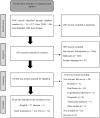Controlling Coxiella burnetii in naturally infected sheep, goats and cows, and public health implications: a scoping review
- PMID: 38425838
- PMCID: PMC10901991
- DOI: 10.3389/fvets.2024.1321553
Controlling Coxiella burnetii in naturally infected sheep, goats and cows, and public health implications: a scoping review
Abstract
Q fever is a worldwide zoonotic disease which domestic ruminants are the main source of infection for humans. This scoping review summarizes the control measures currently available to reduce Coxiella burnetii (Cb) infection in naturally infected sheep, goat and cattle herds. A total of 28 articles were included in the review. A lack of methodological standardization was noted in the articles analyzed. The results indicated that long-term vaccination in cows reduces bacterial excretion in milk and environmental contamination. In small ruminants, the results of vaccination in terms of efficacy are variable. In goats, there is a reduction in bacterial excretion, unlike in sheep, where a long-term vaccination program is necessary to reduce bacterial excretion. Moreover, the high persistence of viable Cb in the environment means that control measures for sheep are needed for several years. The use of antibiotics as a control measure in cows and sheep was not found to reduce excretion. However, the combination of vaccination with antibiotic therapy appears to have positive effects in small ruminants in terms of controlling outbreaks of Q fever. Hygiene and biosecurity measures are the basic means for controlling Cb infection on ruminant farms and ensuring public health.
Keywords: Q fever; control measures; domestic ruminants; one health; scoping review.
Copyright © 2024 Toledo-Perona, Contreras, Gomis, Quereda, García-Galán, Sánchez and Gómez-Martín.
Conflict of interest statement
The authors declare that the research was conducted in the absence of any commercial or financial relationships that could be construed as a potential conflict of interest.
Figures



References
-
- Fox-Lewis A, Isteed K, Austin P, Thompson-Faiva H, Wolfgang J, Ussher J, et al. . A case of imported Q fever in New Zealand. New Zeal Med J. (2019) 132:92–4. - PubMed
-
- ECDC . European Centre for Disease Prevention and Control. Q fever –Annual epidemiological report for 2019. (2019) Available online at: www.ecdc.europa.eu/en/publicationsdata/qfever-annual-epidemiological-rep.... https://www.ecdc.europa.eu/en/q-fever (accessed February 21, 2022).
-
- EFSA . Scientific Opinion on Q fever. (2010). Available online at: https://www.efsa.europa.eu/en/efsajournal/pub/1595 (accessed February 22, 2022).
Publication types
LinkOut - more resources
Full Text Sources

